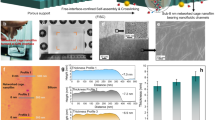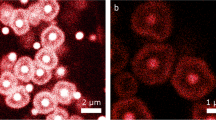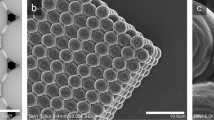Abstract
Microfabricated regular sieving structures hold great promise as an alternative to gels to improve the speed and resolution of biomolecule separation. In contrast to disordered porous gel networks, these regular structures also provide well defined environments ideal for the study of molecular dynamics in confining spaces. However, the use of regular sieving structures has, to date, been limited to the separation of long DNA molecules, however separation of smaller, physiologically relevant macromolecules, such as proteins, still remains a challenge. Here we report a microfabricated anisotropic sieving structure consisting of a two-dimensional periodic nanofluidic filter array. The designed structural anisotropy causes different-sized or -charged biomolecules to follow distinct trajectories, leading to efficient separation. Continuous-flow size-based separation of DNA and proteins, as well as electrostatic separation of proteins, was achieved, demonstrating the potential use of this device as a generic molecular sieving structure for an integrated biomolecule sample preparation and analysis system.
This is a preview of subscription content, access via your institution
Access options
Subscribe to this journal
Receive 12 print issues and online access
$259.00 per year
only $21.58 per issue
Buy this article
- Purchase on Springer Link
- Instant access to full article PDF
Prices may be subject to local taxes which are calculated during checkout






Similar content being viewed by others
References
Scopes, R. K. Protein Purification, Principles and Practice 3rd edn (Springer-Verlag, New York, 1993).
Giddings, J. C. Dynamics of Chromatography. Part 1. Principles and Theory (Marcel Dekker, New York, 1965).
Slater, G. W., Mayer, P. & Drouin, G. Migration of DNA through gels. Methods Enzymol. 270, 272–295 (1996).
Viovy, J.-L. Electrophoresis of DNA and other polyelectrolytes: physical mechanisms. Rev. Mod. Phys. 72, 813–872 (2000).
Woolley, A. T. & Mathies, R. A. Ultra-high-speed DNA fragment separations using microfabricated capillary array electrophoresis chips. Proc. Natl Acad. Sci. USA 91, 11348–11352 (1994).
Yao, G. et al. SDS capillary gel electrophoresis of proteins in microfabricated channels. Proc. Natl Acad. Sci. USA 96, 5372–5377 (1999).
Callewaert, N. et al. Total serum protein N-glycome profiling on a capillary electrophoresis-microfluidics platform. Electrophoresis 25, 3128–3131 (2004).
Liu, L., Li, P. & Asher, S. A. Entropic trapping of macromolecules by mesoscopic periodic voids in a polymer hydrogel. Nature 397, 141–144 (1999).
Nykypanchuk, D., Strey, H. H. & Hoagland, D. A. Brownian motion of DNA confined within a two-dimensional array. Science 297, 987–990 (2002).
Volkmuth, W. D. & Austin, R. H. DNA electrophoresis in microlithographic arrays. Nature 358, 600–602 (1992).
Turner, S. W., Perez, A. M., Lopez, A. & Craighead, H. G. Monolithic nanofluid sieving structures for DNA manipulation. J. Vac. Sci. Technol. B 16, 3835–3840 (1998).
Han, J. & Craighead, H. G. Separation of long DNA molecules in a microfabricated entropic trap array. Science 288, 1026–1029 (2000).
Huang, L. R. et al. A DNA prism: high speed continuous fractionation of large DNA molecules. Nature Biotechnol. 20, 1048–1051 (2002).
Baba, M. et al. DNA size separation using artificially nanostructured matrix. Appl. Phys. Lett. 83, 1468–1470 (2003).
Kaji, N. et al. Separation of long DNA molecules by quartz nanopillar chips under a direct current electric field. Anal. Chem. 76, 15–22 (2004).
Chou, F. et al. Sorting by diffusion: an asymmetric obstacle course for continuous molecular separation. Proc. Natl Acad. Sci. USA 96, 13762–13765 (1999).
van Oudenaarden, A. & Boxer, S. G. Brownian ratchets: molecular separation in lipid bilayers supported on patterned arrays. Science 285, 1046–1048 (1999).
Huang, L. R., Cox, E. C., Austin, R. H. & Sturm, J. C. Continuous particle separation through deterministic lateral displacement. Science 304, 987–990 (2004).
Austin, R. H. et al. Ratchets: the problems with boundary conditions in insulating fluids. Appl. Phys. A 75, 279–284 (2002).
Huang, L. R. et al. Role of molecular size in ratchet fractionation. Phys. Rev. Lett. 89, 178301 (2002).
Fu, J. & Han, J. Continuous-flow biomolecule separation through patterned anisotropic nanofluidic sieving structure. Proc. Micro. Total Anal. Sys. 1, 519–521 (2006).
Ogston, A. G. The spaces in a uniform random suspension of fibres. Trans. Faraday Soc. 54, 1754–1757 (1958).
Rodbard, D. & Chrambach, A. Unified theory for gel electrophoresis and gel filtration. Proc. Natl Acad. Sci. USA 65, 970–977 (1970).
Fu, J., Mao, P. & Han, J. Nanofilter array chip for fast gel-free biomolecule separation. Appl. Phys. Lett. 87, 263902 (2005).
Muthukumar, M. & Baumgärtner, A. Effects of entropic barriers on polymer dynamics. Macromolecules 22, 1937–1941 (1989).
Smisek, D. L. & Hoagland, D. A. Electrophoresis of flexible macromolecules: evidence for a new mode of transport in gels. Science 248, 1221–1223 (1990).
Rousseau, J., Drouin, G. & Slater, G. W. Entropic trapping of DNA during gel electrophoresis: effect of field intensity and gel concentration. Phys. Rev. Lett. 79, 1945–1948 (1997).
Han, J., Turner, S. W. & Craighead, H. G. Entropic trapping and escape of long DNA molecules at submicron size constriction. Phys. Rev. Lett. 83, 1688–1691 (1999).
Smith, F. G. & Deen, W. M. Electrostatic effects on the partitioning of spherical colloids between dilute bulk solution and cylindrical pores. J. Colloid Interface Sci. 91, 571–590 (1983).
Deen, W. M. Hindered transport of large molecules in liquid-filled pores. AIChE J. 33, 1409–1425 (1987).
Fu, J., Yoo, J. & Han, J. Molecular sieving in periodic free-energy landscapes created by patterned nanofilter arrays. Phys. Rev. Lett. 97, 018103 (2006).
Giddings, J. C., Kucera, E., Russell, C. P. & Myers, M. N. Statistical theory for the equilibrium distribution of rigid molecules in inert porous networks. Exclusion chromatography. J. Phys. Chem. 72, 4397–4408 (1968).
Slater, G. W., Gratton, Y., Kenward, M., McCormick, L. & Tessier, F. Deformation, stretching, and relaxation of single-polymer chains: fundamentals and examples. Soft Mater. 1, 365–391 (2003).
Schoch, R. B., Bertsch, A. & Renaud, P. pH-controlled diffusion of proteins with different pI values across a nanochannel on a chip. Nano Lett. 6, 543–547 (2006).
Huang, L. R. et al. Generation of large-area tunable uniform electric fields in microfluid arrays for rapid DNA separation, Tech. Dig. Int. Elect. Dev. Mtg, 363–366 (2002).
Lide, D. R. CRC Handbook of Chemistry and Physics edn 87 (Taylor and Francis, Boca Raton, 2007).
Hagerman, P. J. Flexibility of DNA. Annu. Rev. Biophys. Biophys. Chem. 17, 265–286 (1988).
Rubenstein, M. & Colby, R. H. Polymer Physics (Oxford, New York, 2003).
Giddings, J. C. Unified Separation Science (Wiley, New York, 1991).
Smith, D. E., Perkins, T. T. & Chu, S. Dynamical scaling of DNA diffusion coefficients. Macromolecules 29, 1372–1373 (1996).
Nakanishi, K., Sakiyama, T. & Imamura, K. On the adsorption of proteins on solid surfaces, a common but very complicated phenomenon. J. Biosci. Bioeng. 91, 233–244 (2001).
Schoch, R. B. Transport Phenomena in Nanofluidics: From Ionic Studies to Proteomic Applications. PhD Thesis No. 3538, EPFL, Lausanne (2006).
Margolis, J. & Kenrick, K. G. Polyacrylamide gel-electrophoresis across a molecular sieve gradient. Nature 214, 1334–1336 (1967).
Karnik, R., Castelino, K. & Majumdar, A. Field-effect control of protein transport in a nanofluidic transistor circuit. Appl. Phys. Lett. 88, 123114 (2006).
Eijkel, J. C. T. & van den Berg, A. Nanotechnology for membranes, filters and sieves. Lab. Chip 6, 19–23 (2006).
Wulfkuhle, J. D., Liotta, L. A. & Petricoin, E. F. Proteomic applications for the early detection of cancer. Nat. Rev. Cancer 3, 267–275 (2003).
Righetti, P. G., Castagna, A., Herbert, B., Reymond, F. & Rossier, J. S. Prefractionation techniques in proteome analysis. Proteomics 3, 1397–1407 (2003).
Fu, J. & Han, J. Continuous biomolecule separation in a nanofilter structure. US Patent P-8195-USP, priority date 5 October 2006.
Acknowledgements
We acknowledge financial support from NIH (EB005743), the DuPont–MIT Alliance, NSF (CTS-0347348) and Singapore-MIT Alliance (SMA-II, CE Program). We thank P. Mao for helping take the scanning electron microscopy images and J. Yoo for contributing to the experimental setup. We acknowledge valuable comments on and suggestions for the manuscript by P. Doyle, H. Bow and C. Rothman. The MIT Microsystems Technology Laboratories are acknowledged for support in fabrication.
Author information
Authors and Affiliations
Contributions
J.F. and J.H. conceived and initiated the ANA concept and J.F. designed and fabricated the ANA device. J.F. conceived and performed experiments with short DNA, long DNA and denatured proteins. R.B.S. conceived and performed experiments with native proteins. J.F. and R.B.S. analysed the data. A.L.S. performed gel analysis and J.F. and J.H. developed the theoretical model. J.F. and R.B.S. wrote the manuscript and J.H. and S.R.T. supervized the project.
Corresponding authors
Ethics declarations
Competing interests
The authors declare no competing financial interests.
Supplementary information
Supplementary Information
Supplementary movie S1 (WMV 2802 kb)
Supplementary Information
Supplementary movie S2 (WMV 2802 kb)
Supplementary Information
Supplementary movie S3 (WMV 1700 kb)
Supplementary Information
Supplementary text, figures S1, S2 and video captions (PDF 299 kb)
Rights and permissions
About this article
Cite this article
Fu, J., Schoch, R., Stevens, A. et al. A patterned anisotropic nanofluidic sieving structure for continuous-flow separation of DNA and proteins. Nature Nanotech 2, 121–128 (2007). https://doi.org/10.1038/nnano.2006.206
Received:
Revised:
Accepted:
Published:
Issue Date:
DOI: https://doi.org/10.1038/nnano.2006.206
This article is cited by
-
Development of a microfluidic chip for protein preconcentration using dual gate structure and nanomembrane
Microsystem Technologies (2023)
-
Three-dimensional nanolithography guided by DNA modular epitaxy
Nature Materials (2021)
-
Step-defect guided delivery of DNA to a graphene nanopore
Nature Nanotechnology (2019)
-
Nanofluidic device for continuous multiparameter quality assurance of biologics
Nature Nanotechnology (2017)
-
Exploiting biased reptation for continuous flow preparative DNA fractionation in a versatile microfluidic platform
Microsystems & Nanoengineering (2017)



